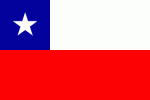
Chile
Quick reference
General issues: Republic 1853-Present
Country name on general issues: Chile
Special issues: Occupation Peru 1881-1882, Postal tax issue Talca 1942
Currency: 1 Condor = 10 Pesos, 1 Peso = 100 Centavos 1853-1960, 1 Escudo = 100 Centesimos, 1 Centesimo = 10 Milesimos 1960-1975, 1 Peso = 100 Centavos 1975-Present
Population: 3 110 000 in 1900, 17 620 000 in 2013
Political history Chile
Establishing the nation
Chili is located in South America. Before colonization, a range of Indian peoples populated the future Chile – in northern Chile the Inca ruled, in central Chile the Mapuche were the largest group of people. The first European to land in Chile is the explorer Magellan in 1520, leading the fleet that would be the first to circumvent the world. The future Chile is colonized by Spain in the later 16th century to become part of the Viceroyalty of Peru as the Captaincy of Chile. The conquest of Spain by Napoleon triggers what would become independence movements all across the the Spanish possessions in the Americas. In 1810, a government is set up in Chile that proclaims Chile to be a self governing state – still loyal however to Spain. Forces striving for full independence soon gain the upper hand and, in 1818, the independent republic of Chile is proclaimed.
Colonization and ‘pacification’
At the time of its declaration of independence, Chile comprises only part of the territory of modern Chile. To the north Chile is bordered by Bolivia. To the south stretch lands yet to be colonized – lands down to the Strait of Magellan. Furthermore, Chile is divided into two parts by the Araucania region – the region where the Mapucho live, who have held the Spanish at bay and have, by the Spanish, been granted self government in the region. In the first part of the 19th century Chile colonizes the lands to the south settling at the Strait of Magellan in the 1840’s. Conflicting claims with Argentina over this territory are settled through border agreements in 1881 and 1902. The Araucania region is largely ‘pacified’ in a number of campaigns between 1861 and 1870, the last battle with the Mapuche to be fought in 1883.
War of the Pacific
Having been involved in the War of the Confederation with the confederation of Peru and Bolivia in 1836-1839 and in the Chincha Islands War with Spain in 1865-1866, Chile will, from 1879 to 1883, be engaged in the War of the Pacific – one of the major conflicts in the history of 19th century South America. At stake were the rich nitrate deposits in the Atacama Desert. In 1866, Chile and Bolivia had signed a border treaty moving the Chilean border – until then only defined by the borders of the former Spanish possessions – up to the 24th degree of south latitude. In a further 1874 treaty Chile had acquired rights north of the recently established border. Considering its rights violated by Bolivia, Chile in 1879 occupied the Antofagasta region. Bolivia declared war on Chile and thus brought Peru into the war, as Peru and Bolivia had signed a treaty of alliance in 1873. The war next moved to Peru. Having first secured naval supremacy, Chile, in a number of successive campaigns, occupied the larger part of Peru, the capital of Lima being occupied in 1881. In 1883, a peace treaty is signed. Peru cedes the Tarapaca region. The Tacna and Arica region are put under Chilean administration with the intention to organize a referendum on the future of these regions. The referendum never takes place. In 1929, Peru and Chile agree to divide the region, Tacna becoming part of Peru, Arica becoming part of Chile. With Bolivia – who in 1880 had effectively stepped out of the war – a truce is signed in 1884, in which Bolivia cedes the Antofagasta region to Chile. In 1904, a further treaty defines the borders.
Pacific Islands and Antarctic claim
Aside from the expansion of Chilean territory thus realized, Chile also comprises a number of islands in the Pacific, including Easter Island or Rapa Nui, annexed in 1888. With Argentina, a border adjustment is agreed upon in 1899. Since 1940, Chile claims a sector of Antarctica overlapping with the Argentinian and British claims. The claim is subject to the Antarctic Treaty signed by Chile in 1959, effective 1961, that pertains to the ice shelves, islands and mainland south of the 60th degree of south latitude. The treaty sets aside the Antarctic as a scientific preserve and stipulates that a presence in the Antarctic does not constitute a basis for a claim to de jure sovereignty. For a map of the Chilean Antarctic Territory please refer to the map of Antarctica.
Political and economical development
Politically Chile is, in the 19th century, dominated by an elite of landowners with a presidency gradually gaining in strength. In 1891, tensions between the presidency and the congress escalate into a civil war that ends in victory for the congress. Chile will be a parliamentary democracy until the presidency is restored in 1916. With the exception of a period of political instability and military dictatorships from 1924 to 1932, Chili is a stable democracy until the 1970’s. The leftist presidency of Salvador Allende, from 1970 to 1973, triggers a military coup d’état – allegedly with the support of the United States – that brings general Augusto Pinochet to power. The coup d’état is followed by a period of strong state repression of the opposition. After increasing protests, Pinochet is forced to transfer power to a democratically elected president in 1990. Since then Chile has once again been a stable democracy.
Economically, Chile has, since the 1980’s, developed into a diversified high income economy. Copper – also found in the Atacama Desert – has replaced nitrate as the most important natural resource. Both in terms of the per capita GDP and the United Nations Human Development Index Chile ranks highest of all countries in South America.
Postal history Chile
The first stamps are issued in Chile in 1853. This first issue, and subsequent issues until 1867, use the same design and have been printed in a wide range of varieties that often can be distinguished only by experienced specialists. With the exception of a few provisionals issued in times of shortages, all stamps issued until 1910 show the portrait of Christopher Columbus – a requirement laid down by law. In 1910, the first set of commemoratives is issued at the occasion of the 100th anniversary of independence. Chile has, until the present day, largely issued stamps with themes of national interest.
Foreign offices have existed in several ports – both British and French offices. The British offices have used British stamps from 1865 until 1881. These British offices handled most of the international mail until Chile joined the UPU in 1881. The French offices existed from 1872 to 1874 and have used French stamps.
During the War of the Pacific, Chile maintained a postal service in the occupied territories in Bolivia and Peru. Most commonly used were the general issues of Chile. These can be found used in a range of cities both in Bolivian littoral and in Peru and may be recognized by the cancels. In 1881 and 1882, specific issues for occupied Peru were released. All these issues are overprints on Peruvian stamps captured by the Chilean authorities, the overprint being the Chilean coat of arms. Two sets of Peruvian stamps were used. The first are the general 1874-1879 issues. The second is a set of stamps prepared by the Peruvian authorities but not yet released. These were, again, the general 1874-1879 issues first overprinted by the Peruvian authorities with a horseshoe and the inscription ‘Universal Postal Union Peru’ to signify that Peru had joined the UPU in 1880 and second by the Chilean authorities with the coat of arms of Chile. Later – in 1883 after the withdrawal of Chile from Peru – this set would be issued as designed with the first overprint only by the Peruvian authorities. The Chilean overprints were released mainly in Lima and Callao but were also available in a number of other cities. Both types were withdrawn in 1882 when it was found that the stamps were forged in large numbers.
Note: The stamps issued under Chilean administration are only part of the complex history of the War of the Pacific. The issues of the Peruvian authorities during this period will be discussed in the profile of Peru.
A local postal tax stamp was issued in 1942 for use in Talca to fund the celebration of the bicentenary of the city.
Album pages

Page 2 of 8
← Previous page: Cayman IslandsNext page: Colombia →

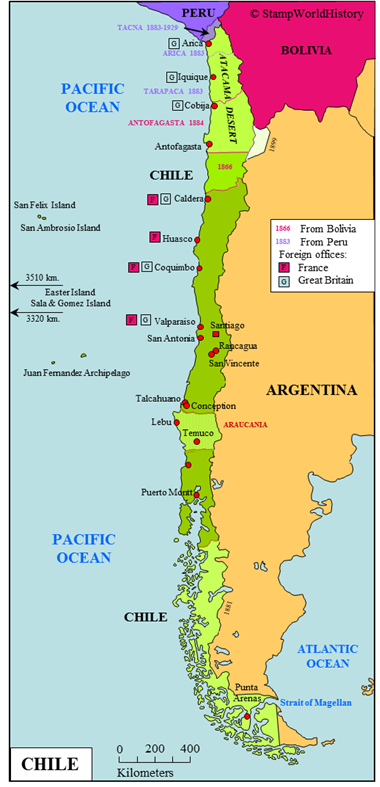
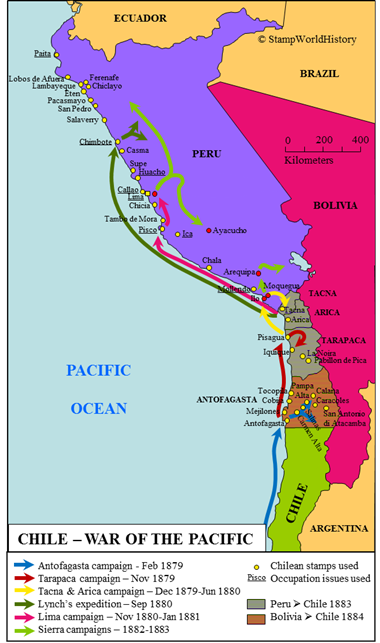
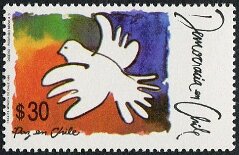
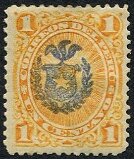
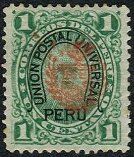







In the third paragraph of Postal History Chile, “again, the general 1974-1979 issues” should be “again, the general 1874-1879 issues”
Thanks, William